Hooked Daisy Chains and Teasers
By Peter Pakula
Introduction
Multiple components using squids, lures, skirts and anything else that may be considered as fish attractors are often used in strings called 'Daisy Chains' with the purpose of exciting fish to bite more aggressively and to bring fish to the lures from a greater distance and depth than single lures.
Daisy Chains are most often used on separate lines to the hooked lures, especially in Australia where the Game Fishing Association of Australia has rules against their use with hooks on rod and reel. However, not all fishermen are members of clubs or they do not always fish for points and records.
The following text can be used as information regarding the possibilities of using Daisy Chains and their many variations in both hooked versions and hook-less teaser-only versions.
They are incredibly effective in increasing your success rates on all predators, especially schooling fish such as Tuna.
The main reason for writing this article is that many new fisheries opening up are targeting big fish in choppy seas with large swells using small boats. Because the height of the chop and swell is greater than the distance from the water to the rod tip and often greater than the distance from the water to outrigger tips the use of separate Daisy Chains leads to crossovers and tangles.
To be effective whenever a separate teaser is used a lure should be deployed in close proximity to it say 10 to 20 feet which is very difficult to do in small boats in big seas.
The solution to these problems is to run the daisy chain on the rod with the hooked lure on it.
Daisy Chains are very easy to put together yourself often with items you already have. There are many, many, possibilities. Following are several examples giving hints to their construction, configuration and positions.
In discussing Daisy Chains there are certain factors that are relevant to all of them.
- Multiple items on a single line create more drag than individual lures so a heavier line class may be needed to effectively use the hooked Daisy Chain, or the size of the Chain components be scaled down in size so that a lighter line class can be used. This is the preferred option as almost without exception lures normally used in an area are larger than necessary to get the best results.
- There are no rules as to how many items can be used on a daisy chain and you can also use different types of items on the same daisy chain. Usually, three to four components are used spaced at 1.5 to 2 feet apart.
- There is more chance of line twist using Daisy Chains. Using swivels between each component will alleviate this problem to a great extent.
- All swivels and snap swivels should be high quality and rated either to or over the leader used in the system.
- Snap swivels used to connect the main line to the Daisy Chain should be rated at twice the line class used.
- If using a wind-on leader (ref: BTL chapter 3 part 5 ) the snap swivels should be rated to or over the leader breaking strain.
- Because of the added commotion created by Daisy Chains, heavier leaders can often be used on most surface running Daisy Chains and Teasers without detrimentally affecting their success.
- There should always be some leader between the first chain item to minimise getting bitten off at the connecting snap swivel.
- There should only ever be hooks used in a single lure. Dealing with large fish on a daisy chain with multiple hooks is too dangerous.
- Daisy Chains can be set up to insert between the snap swivel and the lure leader by putting a loop in the main line end and a snap swivel on the hooked lure end. Once again the snap swivel used should be rated to at least the breaking strain of the leader.
- Because of their length, daisy chains are easier to deploy than single lures and get working 'properly' than a single surface lure.
- Most commonly the daisy chain items are smaller than the hooked lure imitating a larger predator chasing bait. However, there are no fixed rules in Daisy Chain configurations.
The main reason for using Daisy Chains are -
- Imitate a small scared school of baitfish both in profile and action.
- Create greater drag so that lures remain in position in rough seas and strong seas.
- To position lures deeper in the water column.
- 'Switch On' fish that are in the area but not feeding

Fig 1: The various positions and their common names that will be referred to in the following text.
Skirt Daisy Chain:
The skirt daisy chain is the most basic of the Daisy Chains using 'Octopus' skirts (same skirts as used on skirted trolling lures). They are spaced around 1.5 to 2 foot apart with a hooked trolling lure at the end. Often the colours used are the same as the hooked lure.
This type of chain is based on the profile as the skirts have little if any action. Using bright fluorescent colours such as pinks, greens oranges may help, but dark colours such as violet and black give the best silhouette and profile.
You can also just use skirts putting a hook in the last skirt.
Skirted Trolling Lures can be used instead of skirts. Lure chains add action and vibration to the chain which increases the Daisy Chains effectiveness. However, the lures on the chain action is reduced because of the drag by the lures behind it and the drag of the chain on the outfit used is dramatically increased.
Skirted and Lure Daisy Chains work best on the Outrigger and Shotgun Positions.

Fig 2: Skirt Daisy Chain.

Fig 3: Skirt Daisy Chain. The Lure is a Pakula Dojo Peche Uzi and 4-inch squids.

Fig 4: The skirts are held in position using a bead and crimp. The crimp should be the same size as used to crimp the loop on the end of the leader and connect the hook rig. So that crimp holds, insert a small piece of leader inside the crimp so it has two thicknesses of leader to grip on to. The skirt is then pulled down so that the bead sits inside the head of the skirt.
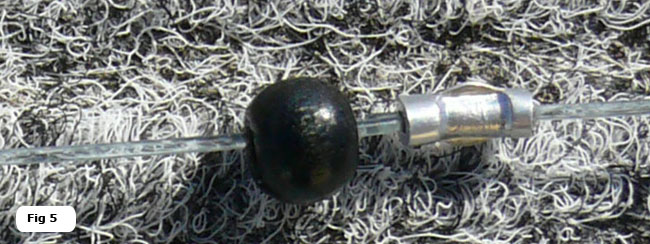
Fig 5: The bead used should be wood (available at craft shops) as it prevents the skirt from pulling over the crimp if a fish hits it. It also adds floatation to the daisy chain. Sinkers and hard plastic beads may chew out the leader. Soft plastic beads may pull over the crimp if the skirt is hit by a fish.
Squid Daisy Chain
Squid is one of the greatest bio-masses on the planet. Using squids on a Daisy Chain is very effective. There are many types of rubber squid imitations in colour size and shape. All of them work well on chains.
Once again this is a profile chain so colours and profile considerations are the same as the skirted Daisy Chain.
They are spaced around 1.5 to 2 feet apart with a hooked trolling lure at the end.
Squids such as the ones below may have a tendency to spin so inserting a swivel between each of the squids and lure is a good idea.
Squid also tend to skate on the surface and are affected greatly by the wind. To increase drag to reduce the effect of wind use lures such as Cockroaches, Mouse, Rat and Wombat.
Squid Daisy Chains work Best in Outrigger and Shotgun positions.

Fig 6: Drawing of Squid and Hooked Lure Daisy Chain

Fig 7: Chain of Squid and Lure. The lure is a Pakula Hothead® Mouse™ with 6-inch rubber squids.
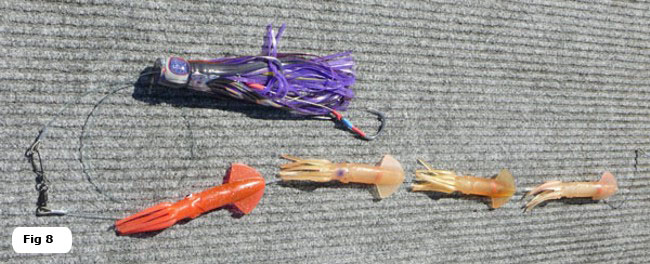
Fig 8: Chain of Squid and Lure. The lure is a Pakula Hothead® Mouse™ with 6-inch rubber squids. The Squid chain is set up to insert into the rig, note the snap swivel connecting the squid chain to the lure leader.
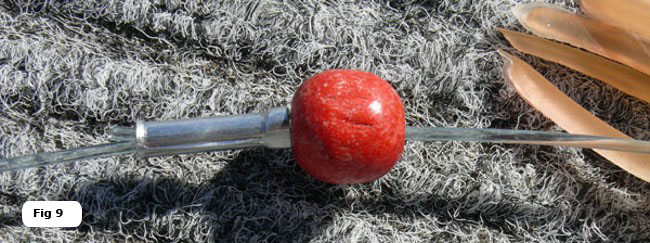
Fig 9: Once again a wooden bead is used in conjunction with a crimp are used to hold the squid in position. Note the small piece of leader used in the crimp so that it is gripping on 2 thicknesses of leader.
Hybrid Daisy Chain
These Daisy Chains use Pakula Dojo Peche® Hybrids. This class of lure includes many baitfish profile rubbers that are not symmetrical, may have weights in them and have a tube from head to tail through which a leader can be passed.
Because of the lures configuration, swivels are a necessary part of the rig so that the lures can align themselves, and not unbalance each other resulting in the chain spinning.
These Daisy Chains work best on the Long Corner and Long Rigger.

Fig 10: Lure sizing in this chain is important. The hooked lure should be the biggest with the chain of lures progressively getting smaller. The benefit of using weighted lures is the ability to stop the boat and drop the lures into deep bait schools is unique to this class of lure. Having the largest lure at the end of the chain ensures the chain won't tangle on the drop.

Fig 11: The lure is held in position by a crimp that sits locked into the back of the lure head. The lure is slipped down the leader until the crimp locks it into place.

Fig 12: Swivels are necessary when using lures that are weighted with a keel such as Dojo Hybrids. The swivels should be rated to the leader breaking strain and using Chaffing gear such as nylon tubing or spring guards helps reduce toothy critters weakening the leader if the swivels get bitten.

Fig 13: The Hybrid hook should be held in position by using a rubber band. See the article 'Hook Point Up'
Bird Daisy Chains:
Of all the Daisy chain configurations the bird teaser is the easiest to set up. They are incredibly effective in targeting all predators.
Birds are greatly affected by wind. To reduce these effects use a lure with heavy drag such as a Cockroach™, Mouse™, Rat™ and Wombat™. Also the greater the drag of the lure the 'harder' the bird works.
The distance of the lure to the bird can be anything from 3 to 12 feet with 6 being common.
You can use more than one bird on a chain, you can also use a bird at the lead of a skirt or Squid Daisy Chain.
There are many brands of Birds available on the market. Use only ones with wooden wings as hooked Daisy Chains as the others will damage lines in tangles.
There are also many in-line birds on the market. There is a great tendency for these to chew through nylon leaders. You may need to use cable through these birds or insert nylon tubing so that the leader is protected from wear.
All positions in the spread are enhanced by using a Bird. Birds work well in any position, even if the bird is pulled out of the water from time to time.

Fig 14: Bird and Lure set-up. Note a safety line is often used in case the wire loops in the bird fail.
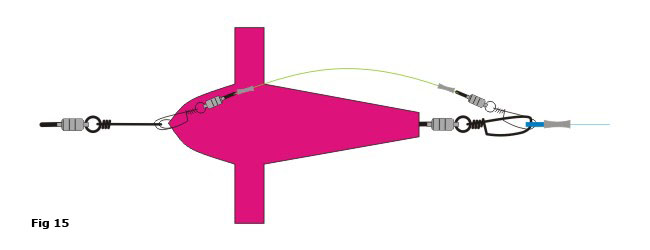
Fig 15: The safety line goes from the snap swivel or leader loop in front of the Bird to the lure leader, so that if the wire loops on the bird fail the fish is not lost. This system is used whenever you use solid lures such as poppers, stick baits, metal lures with split rings etc.
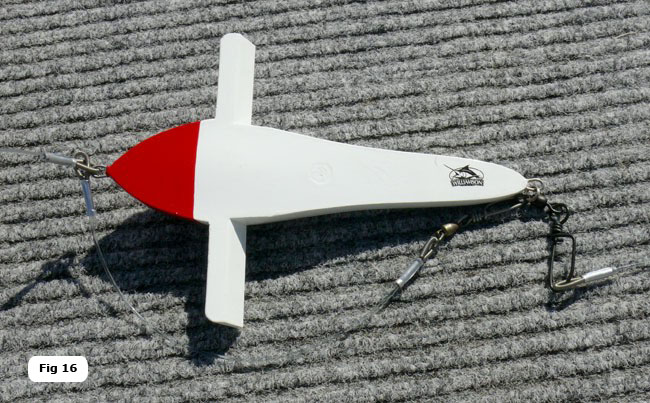
Fig 16: Bird rigged with a safety line.
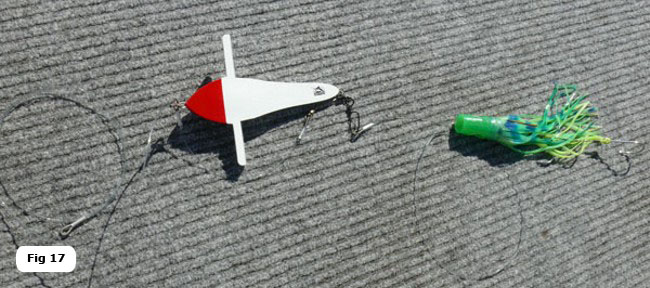
Fig 17: Bird with the hooked lure. In this configuration, the bird is connected to a wind-on leader and lure leader with a safety line also in the system. The lure is a Pakula® Skirted Lure
Bibbed Lure Daisy Chain
Bibbed lures and bibles lures are effective for all sizes of game fish of all species. They and their use are largely misunderstood.
Their use in multiples is pretty much unknown. A few comments that follow may help in understanding how best to use them to get significant results.
Bibbed lure Daisy Chains are best used on the short and long corner positions.
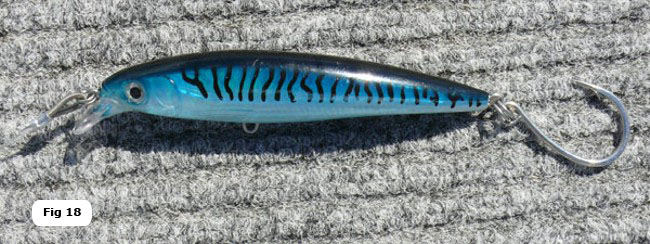
Fig 18: Lures with small bibs are shallow divers. The lure shown is a Rapala X-Rap shallow diver. Generally bibbed lures come with two or more treble hooks which is not the ideal set-up for big fish. A single hook is a better option as it will hook a fish cleanly in the jaw as opposed to a treble that is inclined to catch in the side of the fish's head giving the fish great leverage against you.
The single hook shown is a Decoy JS-1 designed for use with hard-bodied lures. The eye is in line with the bend so the point sits in line with the lure, the shank is also short minimising drag which would restrict the action of the lure.
Another system used is using two split rings and a normal heavy gauge hook. This results in lure slap, dramatically reducing the action of the lure. The increased drag of the single large hook also stops the lure from diving to its potential depth.
To maximise lure action the single hook should not have any more drag, ie surface area, than the hooks they replace, ie, the single hook should not have more drag than the trebles the hook replaces.
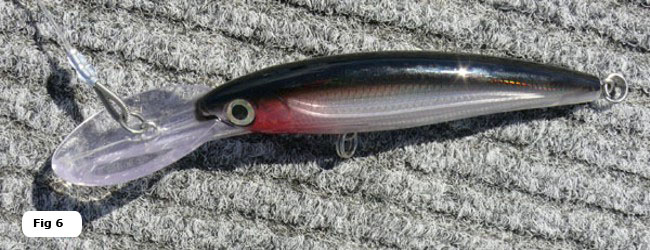
Fig 19: Lures with large bibs such as the Rapala X-Rap shown are deep divers. The longer the bib the deeper the lure will dive. The wider the bib, the more the lure will wobble and the narrower the more it will roll and flash. The lure shown has a long and relatively narrow bib which will imitate saltwater baitfish better than a lure with a wider bib.
Deep diving lures are rated at a speed of 1 to 3 knots on a thin line with no leader.
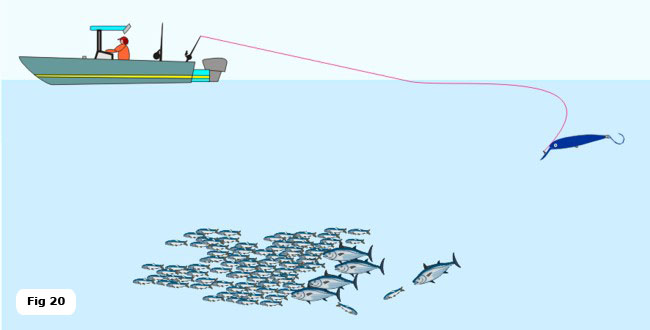
Fig 20: In game fishing lines used are greater than the line the lure was rated with. Often leaders and snap swivels are used in the set-up. Also, speeds used to target game fish when trolling often exceed the speed at which the lures were rated even though the lures would produce better results at much slower speeds.
As a result of a large belly of line forms dragging the lure up so that it doesn't dive to the depths specified on the packet. Often they don't even get to half that depth.
- The thicker and longer the line the more drag there is preventing the lure from diving to its specified depth.
- The thicker and longer the leader the more drag there is preventing the lure from diving to its specified depth.
- The faster you go above say 3 knots the more drag there is preventing the lure from diving to its specified depth,
- The thicker and larger the replacement hook the more drag there is preventing the lure from diving to its specified depth and the more restricted the lure's action is.
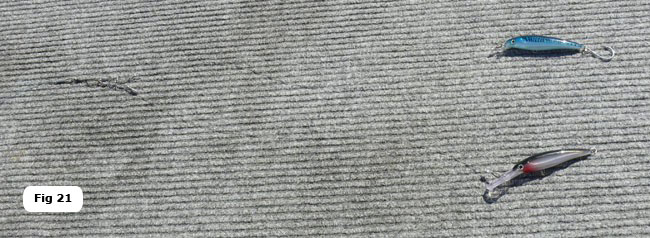
Fig 21: Bibbed lures can be used in groups, not quite a Daisy Chain as they are all run from a central point, more like forming a 'pod' of bait.
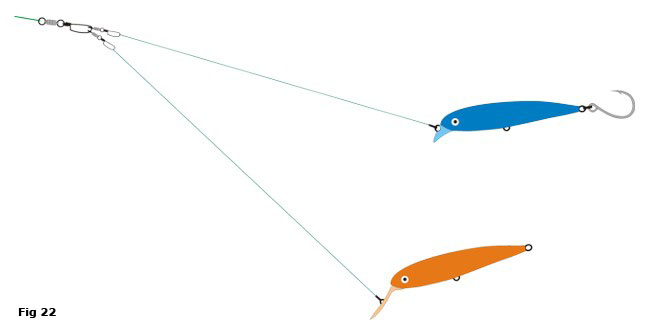
Fig 22: Here we have a deep diving lure used to pull a shallow diver down. You can use several deep divers to get the lures down even deeper. All lures should be pulled from a central point and all should be on separate leaders pulled off the same point, in this case, a snap swivel.
- There should only be a single lure with a hook on it, either the shallowest diver on a longer leader than the others, or the deepest diving lure on the longest leader. To be manageable leaders should be under 6 feet long.
- The thinner the line and leader the deeper the lures will go. Depths multiply, ie two deep diving lures on a relatively thin line will dive almost twice as deep as a single deep diver at the same speed. This opens up the possibility of fishing depths that have not seen lures in many areas.
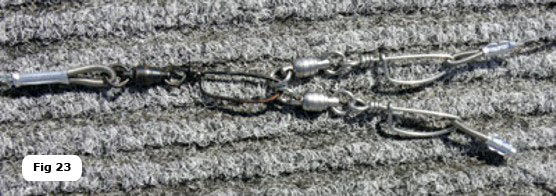
Alternatives
Branched Daisy Chains: One of the many variations in daisy chains uses branches of the leader coming off the main leader to which the items such as skirts, lures, squids etc are connected. Though these are effective they do often tangle with each other and are a major problem if they get tangled with other lines.
Conclusion
There is no question that using Daisy Chains will increase your success rates. The options of combinations and options are endless.
If you are not used to them try them out in the shotgun position to start with and then once you know what they will do use them throughout your pattern.
In rough conditions using two lines with Hooked Daisy Chains would be a better option than trying to run many lines without them.
Also, try slowing down to 3 or 4 knots when using bibbed lures. Pakula Hybrids will work just fine at that speed to help fill your pattern.
This article is only an introduction to some options. Hopefully, you'll be inspired enough to give some of them a go. I'm sure you'll be impressed with the results.
The most recent Daisy Chains available can be found here:
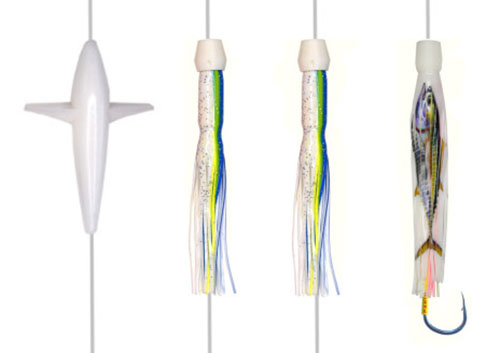
https://buypakula.com/new-2023-no-brainer-daisysquid-chains/





